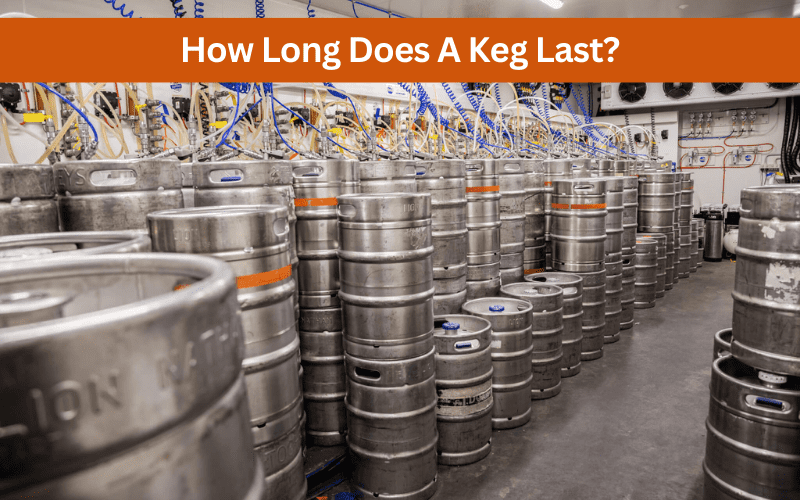For anyone who has ever hosted a party or event where beer was on the menu, the question of how long does a keg last is a critical one. I once threw a backyard BBQ with a keg of my favorite beer, only to find out that it had gone flat and stale halfway through the event. It was a frustrating experience that left me wondering what I could have done differently. That’s why I’ve done some research and put together this guide to help others avoid the disappointment of a bad keg. So, whether you’re a seasoned party host or a first-time keg buyer, read on to learn how long does a keg last and how to keep your keg fresh as long as possible.
What is a Keg?
A keg is a container used for storing and dispensing beer, typically made of stainless steel, aluminum, or plastic. Kegs come in various sizes and are often used in bars, restaurants, and at social events where large quantities of beer are needed.
Understanding the lifespan of a keg is essential for anyone who plans to purchase, use, or store beer in a keg. The lifespan of a keg can affect the taste and quality of the beer and can also impact the amount of money spent on the keg. By knowing how long does a keg last and how to properly store and handle it, beer enthusiasts can ensure they get the most out of their keg and avoid wasting money on spoiled beer.
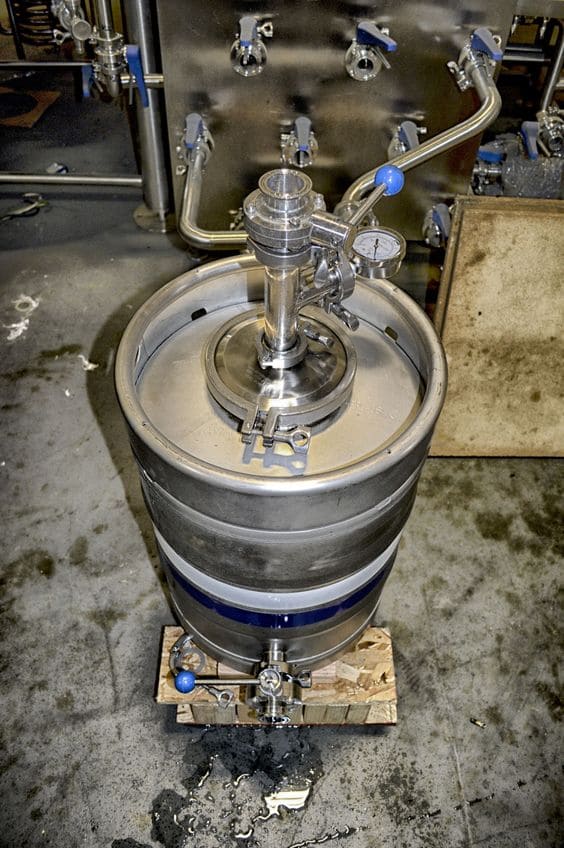
Factors That Affect Keg Lifespan
The lifespan of a keg can be influenced by several factors that can affect the taste, quality, and freshness of the beer. Some of the main factors that impact the lifespan of a keg include:
- Type of beer: Different types of beer have different shelf lives, depending on their brewing process and ingredients. For example, light beers tend to have a shorter lifespan than darker, heavier beers.
- Temperature: The temperature at which the beer is stored can greatly affect its lifespan. Beer stored at warmer temperatures will spoil more quickly than beer stored at cooler temperatures.
- Carbonation level: The carbonation level of the beer can also impact its lifespan. Beer with a higher carbonation level will spoil more quickly than beer with a lower carbonation level.
- Exposure to air: When a keg is tapped, air can enter the keg and affect the beer’s freshness. The longer a keg is exposed to air, the faster the beer will spoil.
- Quality of the keg: The quality of the keg itself can also impact the lifespan of the beer. Old, rusted, or damaged kegs can cause the beer to spoil more quickly.
It’s important to consider these factors when storing and handling a keg to ensure the beer stays fresh and has a longer lifespan.
Types of Kegs
There are several different types of kegs available, each with its own advantages and disadvantages. Here are three of the most common types of kegs:
- Standard Kegs: Standard kegs, also known as full-size kegs or 1/2 barrels, are the most common type of keg. They hold 15.5 gallons of beer and can weigh up to 160 pounds when full. The advantage of a standard keg is that it can hold a large amount of beer, making it ideal for large events. However, they can be difficult to move and store due to their size and weight.
- Pony Kegs: Pony kegs, also known as quarter barrels, are smaller than standard kegs and hold 7.75 gallons of beer. They are easier to move and store than standard kegs and are a good option for smaller parties or events. However, they may not hold enough beer for larger events and may not be available for all types of beer.
- Slim Kegs: Slim kegs, also known as 1/6 barrels, are the smallest type of keg and hold 5.17 gallons of beer. They are even easier to move and store than pony kegs, making them a great option for smaller gatherings or for those with limited storage space. However, they may not be available for all types of beer and may not hold enough beer for larger events.
Do Kegs Go Bad?
Kegs can go bad if they are not stored or handled properly. Exposure to heat, light, and oxygen can all impact the quality and freshness of the beer in a keg.
Signs that a keg has gone bad:
- Cloudy or hazy appearance
- Off-flavors or sour taste
- Flat or low carbonation
- Strange odor or smell
- Visible mold or bacteria growth
If you notice any of these signs, it’s likely that the beer in the keg has gone bad and should not be consumed.
How Long Does Beer Last In a Kegerator?
How long does a keg last depends on several factors such as the type of beer, storage temperature, and whether the keg has been tapped or not. Here are some estimated shelf lives for different types of beer:
- Light beer: 3-4 months
- Amber ale: 6-8 weeks
- India Pale Ale (IPA): 6-8 weeks
- Stout: 6-8 weeks
- Lager: 1-2 months
How long does draft beer remain fresh?
The shelf life for a keg of pasteurized beer is typically around 90-120 days (or 3-4 months), while unpasteurized draft beer will last about 45-60 days (or 6-8 weeks) when stored at the proper temperature. It’s important to consume the beer as soon as possible after tapping to ensure the best flavor and quality.
How long does a tapped keg last?
When using a picnic pump, which uses oxygen instead of carbon dioxide, a tapped keg will only last about 12-24 hours depending on the type of beer and how much oxygen was pumped into it. The oxygen will cause the beer to go flat and spoil quickly, so it’s important to finish the keg within that time frame.
How long does a keg last unrefrigerated?
If a keg is left unrefrigerated, it can quickly spoil and develop off-flavors. It’s not recommended to leave a keg unrefrigerated for an extended period of time, as this can greatly reduce its lifespan and impact the flavor and quality of the beer.
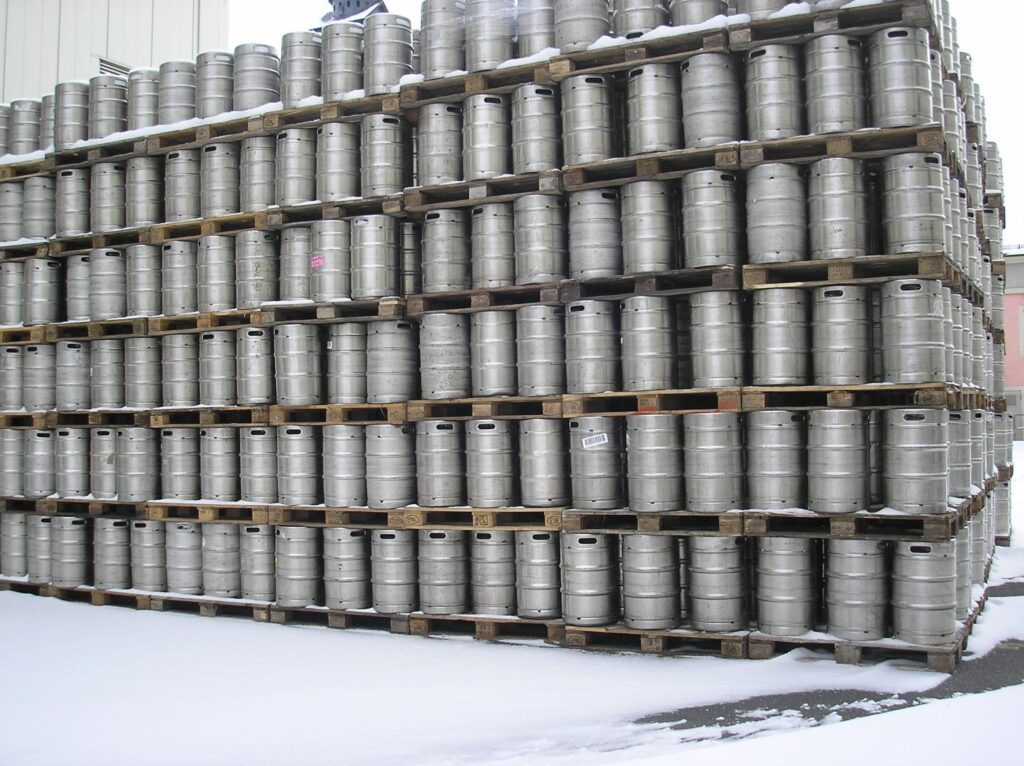
How to Store and Maintain a Keg
Proper storage and maintenance of a keg are critical to ensuring the freshness and quality of the beer. Here are some tips on how to store and maintain a keg:
Tips for keeping draft beer fresh
- Store the keg upright: Kegs should always be stored in an upright position to prevent sediment from settling at the bottom of the keg, which can affect the taste of the beer.
- Keep the keg cool: The ideal temperature for storing a keg is 38 degrees Fahrenheit. This temperature range will help keep the beer fresh and prevent it from spoiling.
- Avoid exposure to light: Kegs should be stored in a cool, dark place to avoid exposure to light, which can cause the beer to develop a “skunky” taste.
- Monitor the carbonation level: It’s important to monitor the carbonation level of the beer in the keg, as too much or too little carbonation can affect the taste and quality of the beer.
- Use a clean tap system: When tapping a keg, it’s important to use a clean tap system to prevent contamination that can cause the beer to spoil.
- Regularly check for leaks: It’s a good idea to regularly check for leaks in the keg and tap system to ensure that the beer stays fresh and doesn’t go to waste.
How to keep a tapped keg fresh
Keeping a tapped keg fresh requires proper storage, handling, and maintenance. Here are some tips for keeping a tapped keg fresh:
- Use a CO2 system: A CO2 system is the preferred method for dispensing beer from a tapped keg because it helps to maintain carbonation levels and prevents the beer from going flat. Make sure the CO2 system is properly connected and adjusted to the right pressure.
- Store the keg properly: The keg should be kept refrigerated at all times, 38 degrees Fahrenheit. Avoid exposing the keg to direct sunlight or heat, as this can cause the beer to spoil.
- Sanitize the tap system: Before tapping the keg, make sure the tap system is clean and sanitized. This will help to prevent contamination and maintain the quality of the beer.
- Limit oxygen exposure: Oxygen exposure can cause the beer to go flat and spoil. Avoid pumping excess air into the keg, and make sure the CO2 system is properly adjusted to prevent excess oxygen from entering the keg.
- Consume the beer quickly: Once a keg has been tapped, it will only last for a limited amount of time. It’s important to consume the beer as soon as possible to ensure the best flavor and quality.
By following these tips, you can help to ensure that your tapped keg remains fresh and flavorful for as long as possible.
What temperature should I store my keg at?
The ideal temperature for storing a keg of beer is between 34 and 38 degrees Fahrenheit (1 to 3 degrees Celsius). However, the most ideal temperature is 38 degrees Fahrenheit. This temperature range helps to maintain the quality and freshness of the beer and prevents it from going flat or developing off-flavors.
Why is storage temperature a matter?
Storage temperature is a critical factor in preserving the quality and freshness of beer in a keg. If the temperature is too warm, the beer will spoil more quickly and may develop off-flavors. If the temperature is too cold, the beer may freeze, which can damage the keg and affect the carbonation level of the beer.
It’s important to store the keg at the ideal temperature range to ensure the beer stays fresh and maintains its quality. If you’re storing a keg for an extended period, it’s recommended to use a kegerator or refrigerator to maintain a consistent temperature.
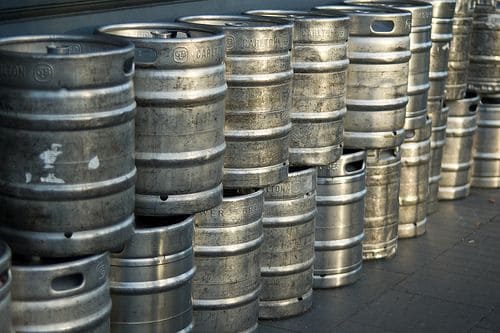
How to Dispense Beer?
Dispensing beer from a keg can be done using either a CO2 system or a hand pump. Here are the general steps for dispensing beer from a keg:
- Connect the tap system: Make sure the tap system is properly connected to the keg and that the CO2 system or hand pump is ready to use.
- Open the tap: Slowly open the tap handle to start dispensing the beer.
- Adjust pressure: Use the CO2 system or hand pump to adjust the pressure to the desired level.
- Pour the beer: Tilt the glass at a 45-degree angle and slowly pour the beer to avoid excessive foam.
How to tap and pour a keg
Tapping and pouring a keg requires a few additional steps before dispensing the beer. Here’s how to tap and pour a keg:
- Chill the keg: Make sure the keg has been properly chilled before tapping to ensure the best flavor and quality.
- Prepare the keg: Remove the plastic cap and wipe down the top of the keg with a clean, damp cloth.
- Tap the keg: Attach the tap system to the keg, making sure it is properly secured. Slowly turn the tap handle to start dispensing the beer.
- Pour the beer: Follow the same pouring steps as above to pour the beer into a glass.
How do I know how much beer to get?
Knowing how much beer to get for an event or gathering can be tricky. As a general rule of thumb, you should plan on each person consuming approximately 1-2 drinks per hour. However, this can vary depending on the length of the event, the number of guests, and their drinking preferences.
To determine how much beer to get, consider the following factors:
- The number of guests attending
- The length of the event
- The types of beer being served
- The drinking habits of the guests
You can also use an online beer calculator to estimate how much beer you’ll need based on the number of guests and the length of the event.
Keg Recycling and Disposal
Kegs are commonly used for storing and dispensing beer, but what happens to them once they’ve served their purpose? Proper disposal or recycling of kegs is important to reduce waste and environmental impact.
Environmental impact of keg disposal
Improper disposal of kegs can have a significant environmental impact. If kegs are not recycled or disposed of properly, they can end up in landfills where they can take hundreds of years to decompose. Additionally, the materials used in kegs, such as aluminum or steel, can be recycled and repurposed, reducing the need for new materials and the energy required to manufacture them.
How to recycle a keg?
Recycling a keg is a relatively simple process. Many kegs are made of materials such as aluminum or steel, which can be recycled. Here are the general steps for recycling a keg:
- Contact your local recycling center to find out if they accept kegs for recycling.
- If the keg has not been cleaned, empty and rinse it out with water to remove any remaining liquid.
- Remove any plastic or rubber parts, such as the tap or handle, before recycling.
- Take the keg to the recycling center for processing.
Alternative uses for empty kegs
Empty kegs can also be repurposed for other uses instead of being recycled or thrown away. Here are some ideas for alternative uses for empty kegs:
- Use as a planter for flowers or plants
- Convert into a grill or smoker
- Use as a base for a table or bar
- Cut in half to create a unique decorative piece
By recycling or repurposing empty kegs, we can reduce waste and help protect the environment while also finding new and creative uses for these versatile containers.
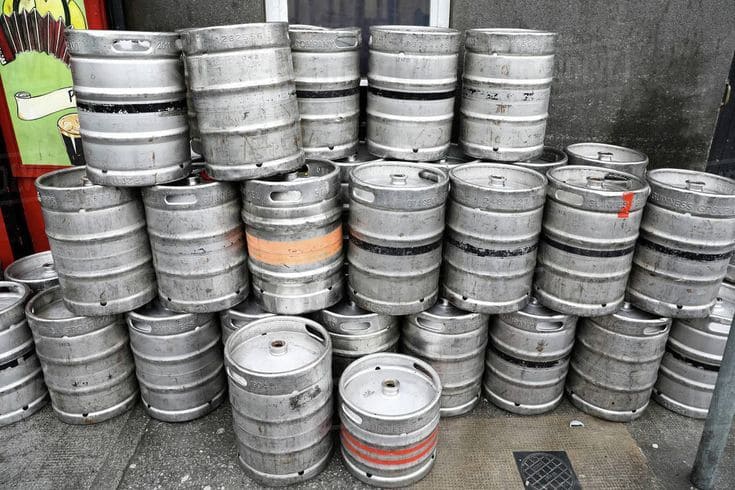
FAQs
How many beers are in a keg?
The number of beers in a keg depends on the size of the keg. A standard keg, also known as a half-barrel, holds around 15.5 gallons or 165 12-ounce servings of beer. Other keg sizes include the quarter-barrel (7.75 gallons) and the sixth-barrel (5.16 gallons).
How do you know when a keg is empty?
You can tell when a keg is empty by checking the flow of the beer from the tap. When the beer stops flowing, the keg is likely empty. You can also check the weight of the keg or use a specialized keg monitoring system to track the amount of beer remaining.
How do you clean a keg?
To clean a keg, first empty any remaining beer and remove the tap and other components. Fill the keg with a cleaning solution, such as a mixture of water and cleaning powder, and let it sit for several minutes. Use a keg brush to scrub the interior of the keg and then rinse thoroughly with water. Let the keg dry completely before refilling.
How much beer is wasted in a keg?
Some beer can be lost during the kegging process due to foam or other factors, but the amount of beer wasted in a keg can vary widely depending on the handling and dispensing practices used. Proper storage and handling can help to minimize waste and ensure that the beer is dispensed with minimal foam and waste.
How long should a keg sit before using?
It’s generally recommended that a keg sit for at least a few hours before using to allow the beer to settle and acclimate to the proper temperature. However, the exact amount of time needed can vary depending on the type of beer and other factors.
Does keg beer have less alcohol?
Keg beer generally has the same alcohol content as bottled or canned beer of the same brand and type. The alcohol content is determined by the brewing process and recipe, rather than the container used for dispensing.
How many times can you tap a keg?
A keg can be tapped multiple times, but the lifespan and quality of the beer can be affected by each tap. Repeated tapping can introduce oxygen and other contaminants to the beer, which can impact the flavor and freshness.
Do kegs go bad if you don’t tap them?
Kegs can go bad if they are not stored or handled properly, but leaving a keg untapped does not necessarily mean it will go bad. Proper storage, temperature control, and handling can help to extend the lifespan of a keg and ensure the beer remains fresh.
Can a keg get warm and still be good?
Kegs should be stored and dispensed at the proper temperature to maintain the freshness and quality of the beer. If a keg gets warm, it can impact the flavor and carbonation levels of the beer and may cause spoilage.
Why is keg all foam?
A keg can produce excessive foam for several reasons, including improper handling, temperature fluctuations, and carbonation issues. To minimize foam, it’s important to handle and dispense the beer properly, maintain the proper temperature, and adjust the carbonation levels as needed.
Conclusion
In conclusion, understanding how long does a keg last and how to properly store and handle it can make a significant difference in the lifespan and quality of the beer. Whether you’re a beer enthusiast or a casual drinker, knowing the factors that affect keg lifespan, the best storage practices, and the signs of a bad keg can help you enjoy your beer to the fullest. From the types of kegs available to the best ways to recycle or repurpose them, the information covered in this article can help you make the most of your keg experience. So, whether you’re planning a party or just enjoying a cold one at home, remember to keep these tips in mind to ensure that your keg lasts as long as possible and maintains its freshness and flavor.
Related posts:
I’m Chen Mina, from Vol de Nuit, who has a special passion for bartending, especially mixing wine, beer, and cooktail. Here you will find content about alcoholic beverages, I will bring you knowledge that few people know about this drink.

